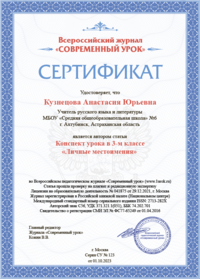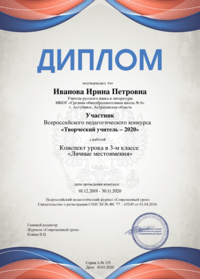Living planet
Автор: Хамракулова Елена Газимовна
Организация: ГБПОУ Уфимский политехнический колледж
Населенный пункт: Республика Башкортостан, г. Уфа
Дистанционный урок состоит из семи разделов, где пошагово раскрываются основные законы экологии, их практическое применение. Вся информация закрепляется наглядными материалами - схемами, моделями, рисунками.
В работе присутствует брейн-ринг, состоящий из 20 актуальных вопросов на тему: «Экология и здоровье».
Разработана и прилагается обширная презентация, дополняющая ход урока.
Дистанционный урок состоит из семи разделов:
1. Вступительное слово.
2. Проблемная ситуация "Нужны ли комары ?".
3. Интерактивная беседа.
4. Информационный блок "Законы экологии".
5. Экологический брейн-ринг
6. Заключительное слово
7. Подведение итогов
Work Annotation
The online lesson consists of seven sections, where the main laws of ecology, their practical application, are revealed step by step. All information is fixed by visual materials - diagrams, models, drawings.
The work contains a brain ring, consisting of 20 topical questions on the topic: "Ecology and health."
An extensive presentation was developed and attached, complementing the course of the lesson.
The lesson consists of seven sections:
1. Introductory remarks.
2. Problematic situation "Do mosquitoes need?"
3. Interactive conversation.
4. Information block "Laws of Ecology."
5. Ecological Brain Ring
6. Final word
7. Summarizing
The English lesson on environmental education
Teacher: Khamrakulova Elena Gazimovna, English teacher, Ufa Polytechnic College
Theme: Living planet
Objectives:
1. Increase children's awareness of environmental laws.
2. To promote patriotism and humane attitude towards the native nature.
3. To form a negative moral assessment of violations in the sphere of nature, a negative attitude towards the thoughtless, irresponsible actions of man in nature.
4. Encourage children to participate in environmental events, to promote environmental ideas.
Design:
a) on the screen - epigraph:
"I ripped off the flower - and he took away.
I caught a moth
And he died in my palm.
And then I realized,
What to touch beauty
You can only with your heart. "
Gvezdoslav Pavol (1849-1921) - Slovak poet
b) Four laws of ecology:
1. Everything is connected with everything else.
2. Everything must go somewhere.
3. There is no such thing as a free lunch
4. Nature knows best.
Plan of the lesson:
1. Introductory remarks.
2. Problematic situation «Do mosquitoes need»?
3. Interactive conversation.
4. Information block «Laws of Ecology».
5. Ecological Broken Ring
6. Final word
7. Summarizing
- Introduction:
Teacher: Here we say: Earth, Earth... We walk on the ground, swim, travel. We use it’s gifts, get it’s bowels, pump out (sometimes barbarically) it’s resources, cut down forests, pollute rivers and lakes, drain swamps... And we think that it will always be so that nature has a lot of reserves that we need and will be enough for everyone. Is that so? (demonstration of the apple as a model of the Earth).
- I have a green apple in my hands, as you have already guessed - this is a model of the Earth. (Fig. 1).

Fig. 1 Earth Model
- Divide our apple into four parts: one part surrounded by three parts. Question to the group: What is one part and what is three parts? (Note: if the guys find it difficult to answer, then paint three parts of the apple in blue, and one in green. Possible answer: the green part is land, and the blue part is water).
- The green part is conditionally divided into three parts. On one of the parts we will install a house.
Question: Why did we install a house on only one third of the green part of the apple? (Approximate answer: only 1/3 part of the land is suitable for the life of people and animals).
- Look, students, what small part of our planet is suitable for life and the Earth's population is about 7 billion! And all humanity at the same time needs daily food, water, air. And often the needs of humanity are many times greater than its real needs, which can lead to an environmental catastrophe. The only salvation is to hear the voice of nature, listen to its laws, use its gifts wisely.
2. Problem situation "Do mosquitoes need?"
Teacher: One familiar fisherman remembered the lesson of ecological culture that one of the Evenk’s resident of the Kolyma taiga gave him for life. Together they caught fish on the banks of the river, where clouds of mosquitoes flew. "Eh, if there would be a scientist who would exterminate all these annoying «vampires» ! - the fisherman exclaimed in his hearts. Evenk, who sat next to him, without saying a word, took the newly caught harius fish and cut his thick abdomen with a knife. The fish stomach was filled with mosquitoes...
3. Interactive conversation.
Teacher: What environmental lesson did a fisherman receive? (Approximate answer:
1) if you exterminate mosquitoes, then the fish that feeds on them will disappear. And if the fish disappears, people will starve!
2) in nature everything is in equilibrium, everything is interconnected).
What examples of ecological imbalance do you know? (Example - the Aral Sea, which is shallow due to the fact that from the rivers that feed it, a person takes a lot of water to irrigate his lands).
4. Information Block of laws of Ecology
Teacher: As we see, nature can brutally punish those who do not take into account its laws. Meanwhile, there are only four of these laws, they are so easy to remember!
So, four laws of Ecology. They were formulated by an American scientist, ecologist Barry Commoner. We wrote these laws on the board.
- The first law: "Everything is connected to everything else."
We have already seen the effect of this law on our examples.
- The second law states: "Everything must go somewhere." Nothing disappears without a trace, including garbage and waste (each of us has 200 kg of garbage!), Which we discard, some of which is burned or buried in the ground. But not all garbage, unfortunately, decomposes.
For example, perform a test (distributed to each student):
Ecology Test
Task: to determine how long garbage decomposes in nature:
1. Travel ticket
a) 2-4 weeks b) 3 months a) year
2. Banana peel
a) year b) 6 months c) 15 days
3. Woolen sock
a) 6 months b) year c) 5 years
4. Wooden stick
a) year b) 4 years c) 15 years
5. Painted board
a) 2 years b) 5 years c) 10 years
6. Waxed Paper Cup
a) year b) 3 years c) 5 years
7. Canning cans
a) 50 years b) 100 years c) 25 years
8. Aluminum cans
a) 50 years b) 100 years c) 500 years
9. Plastic products (bottles)
a) 100 years b) 200 years c) 500 years
10. Glass packaging
a) 100 years b) 500 years c) never
Key: 1-a; 2-b; 3-b; 4-b; 5-c; 6-c; 7-b; 8-c; 9-c; 10-c
Teacher announces the correct answers, students are checked.
Teacher: As we can see, the results of our negligent attitude to nature can be deplorable. But we can make a difference! How? - start with yourself. Let's think together what steps can be taken to reduce the amount of garbage in our environment. (fig. 2). Task: on paper pieces, children record ideas check them with a poster.

Fig. 2 Start with yourself
- The third law of ecology: "Nature knows best." Remember, nature has no waste. For any organic matter in nature, there is an enzyme that can decompose this substance. Well, man created and continues to create a huge number of chemicals that, getting into the natural environment, do not decompose, but accumulate and contaminate it. However, each civilized state is obliged to recycle the accumulated tons of garbage in numerous landfills as much as possible (Fig. 3). What can be made of discarded materials (glass, plastic, wood, etc.)? Write everything you know about it. Children independently perform the task on pieces of paper and are checked with the drawing.

Waste can be processed into new products
Fig. 3. Waste treatment
- The fourth law: «There is no such thing as a free lunch». Man, polluting the environment with poisons, chemicals, other harmful substances, thinks that these substances will not affect his health. Man, draining dirty sewage into the river, believes that these waters will not return to him. However, you will have to pay for everything, because the pollutants will return along the cycle of substances to us through food, water, air. (fig. 4).

Fig. 4. Principle of the fourth law of Ecology
5. Brain ring on the topic: Ecology and health.
Rules of the game. Two commands are called to the ring, which pulled 1 and 2 numbers. The host asks the question, 30 seconds are given for the answer. If the answer is incorrect, the answer right goes to another command. The team that will score the most quantity of points wins.
Questions
1. When garbage is burned in the city, the air is contaminated with poisonous substances. Name the 4 main hazardous substances.
Answer: dioxins, carcinogens, carbon dioxide, radionuclides.
2. Name a few simple techniques for removing nitrates from vegetables.
Answer: soaking, boiling, pickling.
3. It is better to settle tap water before consumption. Why?
Answer: to get rid of chlorine compounds, which volatilize within 2 hours.
4. Name a substance that completely neutralizes the effects of nitrates?
Answer: Vitamin C.
5. Which everyday foods are most dangerous to health?
Answer: sugar and salt.
6. Name the strongest source of air pollution in your area.
Answer: students should name environmentally hazardous objects the settlement (thermal power plants, specific factories, cars, etc.).
7. What do you need to do before eating pesticide-treated fruits?
Answer: cut the peel
8. What percentage of water available on Earth is suitable for drinking?
Answer: 0.005%
9. When does a car emit more toxic substances?
Answer: idling.
10. What heavy metal is intensively polluted by air from vehicles?
Answer: lead.
11. Where's the cleanest water in the world?
Answer: in Lake Baikal. Baikal is the cleanest natural storage of fresh drinking water on Earth. The purity of the water is such that sometimes visibility reaches 40 m.
12. One of the "enemies" of humans is malarial mosquito and other types of fevers. What happens if you manage to get rid of all mosquitoes in some way?
Answer: Natural equilibrium will be disturbed. Mosquito larvae are feed for many species of fish. You can cause the death of several other species by breaking the food chain.
13. What are the effective ways to decontaminate water during the campaign?
Answer: boiling, addition of iodine at the rate of 2 drops per 1 liter.
14. Name the most toxic metal
The answer is mercury.
15. Name the most polluted city in Russia and why?
Answer: Norilsk. Activities of the plant in the extraction and production of nickel, copper. Toxic emissions in the atmosphere.
16. What do you know about the symptoms of mercury vapour poisoning?
Answer: general weakness, lack of appetite, headache, swallowing pain, metallic taste in the mouth, salivation, swelling and bleeding of the gums, nausea and vomiting. As a rule, severe abdominal pain, mucous diarrhea (sometimes with blood) appear.
17. What is the danger of phenol to humans?
Answer: phenol poisoning causes damage to the central nervous system, nervous disorders accompanied by headaches and loss of consciousness, as well as damage to the kidneys, liver, respiratory organs and cardiovascular system.
18. What are pesticides?
The answer is to protect plants from pests and diseases.
19. What is the name of body poisoning caused by expired preserves?
Answer: Botulism
20. What is the danger of acid rain?
Answer: discoloration of fabrics, corrosion of metal surfaces, destruction of building materials and death of vegetation.
6. Final word
Teacher: today we talked about important laws of Ecology. Knowledge, understanding and implementation of these laws is a sign of ecological culture and responsibility. However, this is not enough. There must be an ecology of the soul. Let's read the epigraph again for our lesson. What is the poet talking about here? The fact that we are human should be especially careful about the environment as our own home, not polluting or disturbing this amazing natural harmony and beauty!
7. Summarizing
Teacher: what did you learn new from today's conversation, what do you remember? And can you consider yourself ecologically cultured?
Answers:
- Remembered the story of Evenk, which cut the fish and showed mosquitoes in it.
- Remember the basic laws of ecology and their application
- Many wastes can be processed into new products
- Learned how to observe the ecological culture.
Thank you for your attention! I hope that our cool hour will be useful and instructive!

 БЕСПЛАТНЫЕ семинары
БЕСПЛАТНЫЕ семинары



